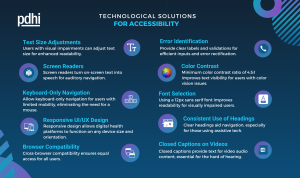Enhancing Accessibility in Digital Health Solutions

The integration of digital technology in healthcare has revolutionized how we access medical services and information. However, these advancements must be accessible to everyone, including the 42.5 million Americans, roughly 13% of the population living with disabilities. This blog explores how digital health platforms can enhance accessibility by complying with regulatory standards and incorporating inclusive design principles.
Compliance with Accessibility Standards
The Importance of Accessibility Standards
Digital health platforms are subject to various legal requirements designed to ensure accessibility for all users. Key among these are Section 508 of the Rehabilitation Act and the Americans with Disabilities Act (ADA). Section 508 mandates federal agencies to provide equal access to Information and Communication Technology (ICT) for people with disabilities. Similarly, the ADA and Section 1557 of the Affordable Care Act enforce non-discrimination in information and communication technology (ICT) accessibility in healthcare settings.
Understanding WCAG 2.0
Section 508 incorporates by reference the Web Content Accessibility Guidelines (WCAG) 2.0 success criteria and conformance requirements to both web and non-web electronic content. These guidelines offer a wide range of recommendations aimed at making web content accessible for people with disabilities, including visual, auditory, physical, speech, cognitive, and neurological disabilities. For digital health platforms, complying with WCAG 2.0 Level AA is fundamental to ensuring that services are accessible to a broader audience.
Real-world Applications
Companies like PDHI lead by example, incorporating these standards to improve accessibility. Features such as text size adjustments, screen readers, and keyboard-only navigation are vital for users with physical disabilities, while simple language and clear content structure help those with cognitive impairments.
Key Technologies Enhancing Accessibility
Ensuring Broader Accessibility
The integration of universal design principles in software and web development should emphasize the importance of adhering to accessibility standards that promote inclusivity and ensure that everyone can effectively navigate and benefit from digital content.
Adherence to universal software and web development design principles:
- Accessibility First: Digital solutions should integrate accessibility guidelines, such as WCAG, into every element of product design and development, ensuring that all users, especially those with disabilities, have full access to digital content and functionalities.
- Consistency and Familiarity: The technology should maintain consistent design standards across all platforms and devices. Utilizing frameworks like Bootstrap should offer familiar interaction patterns that make navigation intuitive for all users, regardless of their previous experience with the platform.
- Flexibility and Customization: The technology should provide robust customization options that allow clients to adapt the interface and features to meet their specific branding and user experience needs without compromising accessibility and usability.
- Clarity and Simplicity: The technology should aim to deliver information and functionalities clearly and concisely. Simplifying complex processes and minimizing the cognitive load on users is essential to enhance overall usability and facilitate efficient interaction.
- Empathy and User-Centricity: The technology should be developed with a deep understanding of user needs, incorporating user feedback through continuous research and testing. This approach ensures the solutions are genuinely responsive and user-focused, leading to higher satisfaction and better user engagement.
- Continuous Improvement: The technology should commit to ongoing improvement, regularly updating and refining its features based on user feedback and emerging best practices. This iterative process is crucial to adapt to changing user needs and technological advancements, ensuring long-term relevance and effectiveness.
PDHI’s Commitment to Accessibility
PDHI exemplifies a commitment to accessibility with a user-centric design philosophy and an adherence to accessibility standards, demonstrating a robust commitment to providing inclusive digital health solutions.
Enhancing accessibility in digital health platforms is a regulatory obligation and a moral one. It ensures that everyone, regardless of disability, has equal access to health information and services. By adhering to established standards, leveraging technology, and focusing on inclusive design, digital health platforms can lead the way in creating a more accessible and equitable healthcare system.


